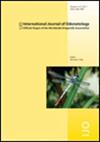Life cycle and seasonal regulation of Onychogomphus forcipatus unguiculatus in the Seybouse River, Algeria (Insecta: Odonata)
IF 1
4区 农林科学
Q3 ENTOMOLOGY
引用次数: 0
Abstract
Understanding the seasonal regulation and life cycle patterns of Odonata is critical to identifying the factors that influence their voltinism. While the life history and seasonal regulation of Odonata, particularly gomphids, has been studied extensively, few studies have focused on North African gomphids. This study aims to contribute to the understanding of the life cycle of Onychogomphus forcipatus unguiculatus (Vander Linden, 1823), a western Mediterranean gomphid, on the Seybouse River in northeastern Algeria and discuss its seasonal regulation. Our results imply that a generation of O. f. unguiculatus requires two years to develop. The appearance of small (F-6) larvae in early spring can be attributed to the hatching of eggs in the previous year, followed by their overwintering in interstitial habitats. This abrupt appearance of small larvae is the result of their unique life history strategy of developing and surviving in specialized habitats during winter, then continuously growing and developing. The senior cohort overlaps with its junior counterpart, overwintering primarily in instars F-1, F-2, and, to a lesser extent, F-3, before beginning to emerge in late spring and early summer. By examining the voltinism and life cycle patterns of O. f. unguiculatus, this study contributes to our understanding of the reproductive strategies and population dynamics of this western Mediterranean gomphid, as well as of factors affecting the phenology and ecology of Odonata, particularly in North Africa, and in this manner contributes to overall efforts to protect and manage freshwater ecosystems in this region.阿尔及利亚 Seybouse 河中 Onychogomphus forcipatus unguiculatus 的生命周期和季节调节(昆虫纲:鸟形目)
了解蜻蜓的季节性调节和生命周期模式对于确定影响其伏季活动的因素至关重要。虽然人们已经对蜻蜓(尤其是蜚蠊)的生活史和季节调节进行了广泛研究,但很少有研究关注北非蜚蠊。本研究旨在帮助了解阿尔及利亚东北部 Seybouse 河上地中海西部鹅虻 Onychogomphus forcipatus unguiculatus(Vander Linden,1823 年)的生命周期,并讨论其季节性调节。我们的研究结果表明,O. f. unguiculatus 的一代发育需要两年时间。早春出现的小幼虫(F-6)可归因于前一年的卵孵化,然后在间隙栖息地越冬。小幼虫的突然出现是其独特生活史策略的结果,即冬季在专门的栖息地发育和生存,然后不断生长发育。高龄幼虫与低龄幼虫重叠,主要以 F-1、F-2 以及少量 F-3 阶段越冬,然后在春末夏初开始出土。通过研究 O. f. unguiculatus 的伏蛰和生命周期模式,本研究有助于我们了解这种地中海西部鹅蚜的繁殖策略和种群动态,以及影响鸟纲昆虫的物候学和生态学的因素,尤其是在北非,从而有助于保护和管理该地区淡水生态系统的整体工作。
本文章由计算机程序翻译,如有差异,请以英文原文为准。
求助全文
约1分钟内获得全文
求助全文
来源期刊

International Journal of Odonatology
ENTOMOLOGY-
CiteScore
2.30
自引率
0.00%
发文量
15
审稿时长
>12 weeks
期刊介绍:
International Journal of Odonatology (IJO) is aimed at providing a publication outlet for the growing number of students of Odonata. It will address subjects such as the ecology, ethology, physiology, genetics, taxonomy, phylogeny and geographic distribution of species. Reviews will be by invitation, but authors who plan to write a review on a subject of interest to the journal are encouraged to contact the editor.
 求助内容:
求助内容: 应助结果提醒方式:
应助结果提醒方式:


